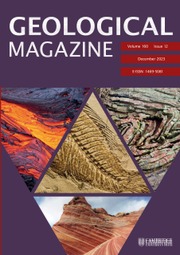Crossref Citations
This article has been cited by the following publications. This list is generated based on data provided by
Crossref.
Reed, F. R. Cowper
1909.
V.—Notes on Phacops Weaveri, Salter.
Geological Magazine,
Vol. 6,
Issue. 2,
p.
69.
Raw, Frank
1925.
The Development of
Leptoplastus Salteri
(Callaway), and of other Trilobites (Olenidæ, Ptychoparidæ, Conocoryphidæ, Paradoxidæ, Phacopidæ, and Mesonacidæ)
.
Quarterly Journal of the Geological Society of London,
Vol. 81,
Issue. 1-4,
p.
223.
Shaw, Frederick C.
1974.
Simpson Group (Middle Ordovician) Trilobites of Oklahoma.
Journal of Paleontology,
Vol. 48,
Issue. S6,
p.
1.
Vandenberg, A.H.M.
Rickards, R.B.
and
Holloway, D.J.
1984.
The Ordovician-Silurian boundary at Darraweit Guim, central Victoria.
Alcheringa: An Australasian Journal of Palaeontology,
Vol. 8,
Issue. 1,
p.
1.
Tremblay, James V.
and
Westrop, Stephen R.
1991.
Middle Ordovician (Whiterockian) trilobites from the Sunblood Formation, District of Mackenzie, Canada.
Journal of Paleontology,
Vol. 65,
Issue. 5,
p.
801.
Owen, A. W.
and
Clarkson, E. N. K.
1992.
Trilobites from Kilbucho and Wallace’s Cast and the location of the Northern Belt of the Southern Uplands during the late Ordovician.
Scottish Journal of Geology,
Vol. 28,
Issue. 1,
p.
3.
Lespérance, Pierre J.
and
Weissenberger, John A. W.
1998.
Trilobites of the Pabos Formation (Ashgillian, Upper Ordovician), Percé area, Quebec.
Journal of Paleontology,
Vol. 72,
Issue. 2,
p.
303.
CRÔNIER, CATHERINE
2007.
LARVAL MORPHOLOGY AND ONTOGENY OF AN UPPER DEVONIAN PHACOPID: NEPHRANOPS FROM THURINGIA, GERMANY.
Journal of Paleontology,
Vol. 81,
Issue. 4,
p.
684.
DE CARVALHO, MARIA DA GLORIA PIRES
and
DA FONSECA, VERA MARIA MEDINA
2007.
The Trilobite “Dalmanites” Maecurua Clarke, 1890 (Middle Devonian, Amazon Basin, Brazil) and the New Genus Amazonaspis (Synphoriidae).
American Museum Novitates,
Vol. 3591,
Issue. ,
p.
1.
Shaw, Frederick C.
and
Bolton, Thomas E.
2011.
Ordovician trilobites from the Romaine and Mingan formations (Ibexian-late Whiterockian), Mingan Islands, Quebec.
Journal of Paleontology,
Vol. 85,
Issue. 3,
p.
406.
Adrain, Jonathan M.
2013.
Chapter 20 A synopsis of Ordovician trilobite distribution and diversity.
Geological Society, London, Memoirs,
Vol. 38,
Issue. 1,
p.
297.
Crônier, Catherine
and
Congreve, Curtis
2013.
Morphological disparity and developmental patterning: contribution of phacopid trilobites.
Palaeontology,
Vol. 56,
Issue. 6,
p.
1263.
Ghobadi Pour, Mansoureh
Ghavidel-Syooki, Mohammad
Álvaro, J. Javier
Popov, Leonid E.
and
Ehsani, Mohammad H.
2015.
First reported Late Ordovician trilobites from the High Zagros Ranges, Iran: A biogeographic link between Gondwanan Chinese and Mediterranean faunas.
Geobios,
Vol. 48,
Issue. 5,
p.
351.
Swisher, Robert E.
Westrop, Stephen R.
and
Amati, Lisa
2016.
Systematics and paleobiogeographic significance of the Upper Ordovician pterygometopine trilobiteAchatellaDelo, 1935.
Journal of Paleontology,
Vol. 90,
Issue. 1,
p.
59.
Drage, Harriet B.
Laibl, Lukáš
and
Budil, Petr
2018.
Postembryonic development ofDalmanitina, and the evolution of facial suture fusion in Phacopina.
Paleobiology,
Vol. 44,
Issue. 4,
p.
638.
CRÔNIER, CATHERINE
ABBACHE, ABDELKADER
KHALDI, AHMED YACINE
OUDOT, MORGANE
MAILLET, SÉBASTIEN
and
OUALI MEHADJI, ABDELKADER
2018.
Middle Devonian trilobites of the Saoura Valley, Algeria: insights into their biodiversity and Moroccan affinities.
Geological Magazine,
Vol. 155,
Issue. 4,
p.
811.
Rong, Jiayu
Wei, Xin
Zhan, Renbin
and
Wang, Yi
2018.
A deep water shelly fauna from the uppermost Ordovician in northwestern Hunan, South China and its paleoecological implications.
Science China Earth Sciences,
Vol. 61,
Issue. 6,
p.
730.
Jacobs, Gabriel S.
and
Carlucci, Jesse R.
2019.
Ontogeny and shape change of the phacopid trilobite Calyptaulax.
Journal of Paleontology,
Vol. 93,
Issue. 06,
p.
1105.
Ghobadi Pour, Mansoureh
Popov, Leonid E.
Owens, Robert M.
Vinogradova, Elena A.
and
Klishevich, Inna A.
2019.
Early Devonian (Lochkovian) trilobites and brachiopods from the west Balkhash Region, Kazakhstan and their significance for regional terrane dynamics.
Geobios,
Vol. 56,
Issue. ,
p.
49.
Ebbestad, Jan Ove R.
and
Fortey, Richard A.
2020.
Late Ordovician trilobites from the Taimyr Peninsula, Arctic Russia.
Journal of Systematic Palaeontology,
Vol. 18,
Issue. 1,
p.
1.

